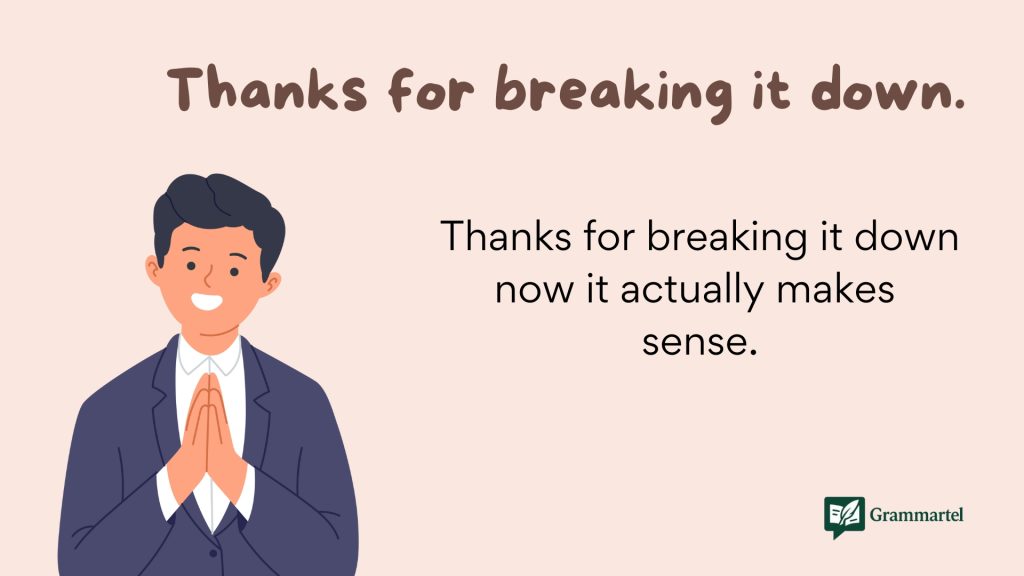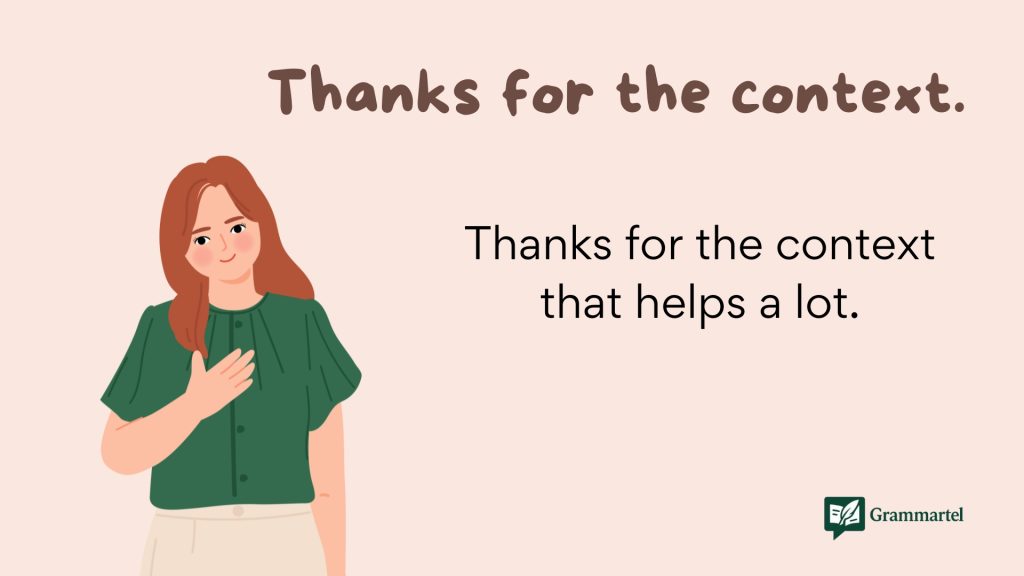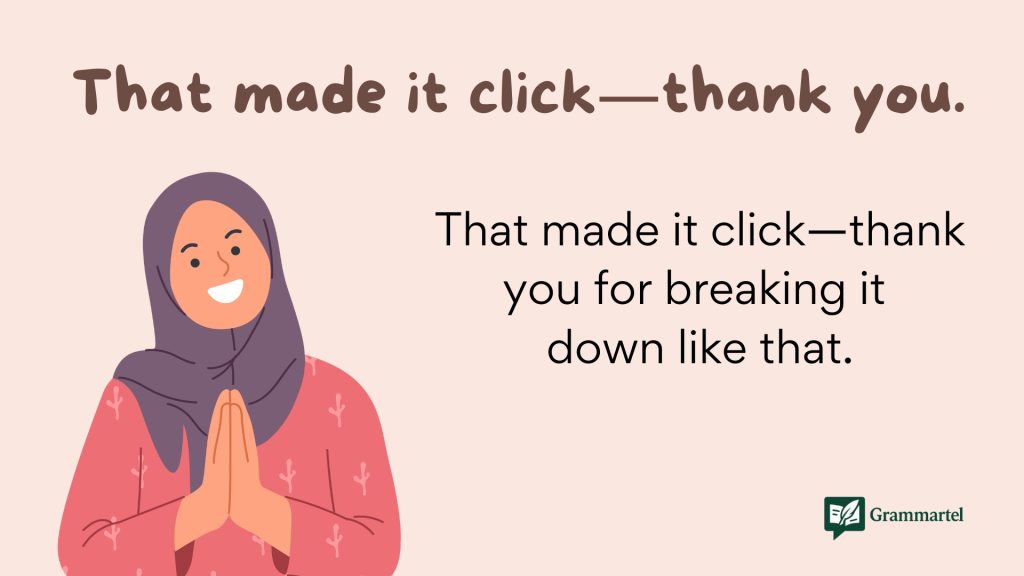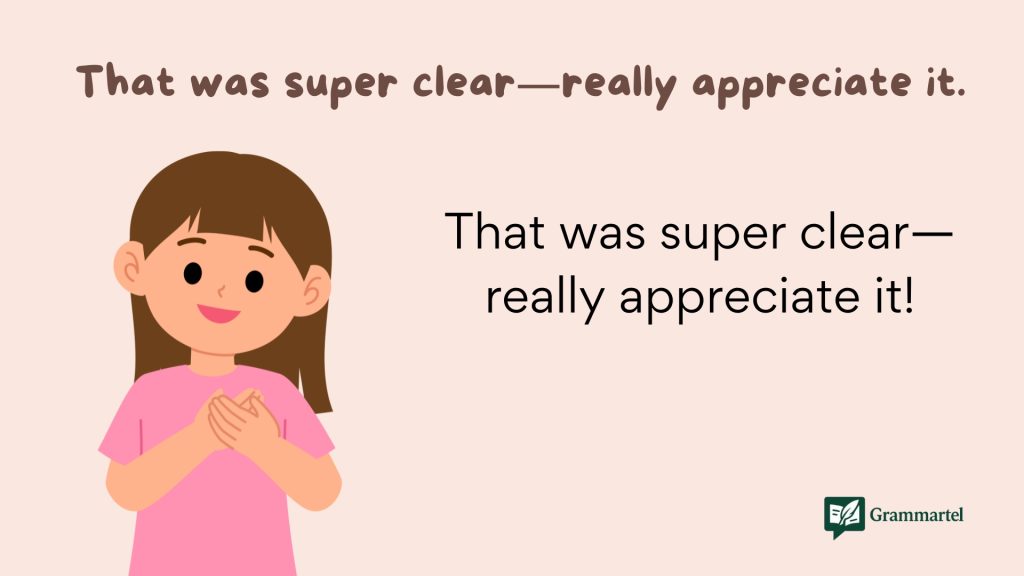Saying “thank you” the right way can really make a difference—especially when someone takes the time to explain something to you. Whether it’s a coworker helping with a tricky task or a friend breaking down something new, showing appreciation is just good manners. But instead of using the same phrase over and over, why not mix it up a bit? In this guide, you’ll find 40 professional ways to say “Thank you for the explanation,” complete with real examples.
What Does “Thank You for the Explanation” Mean?
“Thank you for the explanation” is a polite way to show you appreciate someone taking the time to make something clear. It means you listened, understood, and value their effort. You might say it after someone explains a rule, task, idea, or problem. It’s simple, but it shows good manners and respect.
When to Use “Thank You for the Explanation”
You can use this phrase in many settings—work, school, meetings, or even casual talks. It’s helpful after someone clears up confusion or answers your questions. For example, if a coworker explains how to use a tool or your teacher explains a topic again, this phrase fits. It’s a nice way to close the conversation and show you were paying attention.
40 Professional Ways to Say “Thank You for the Explanation”
1. Thanks for breaking it down.

Meaning: Appreciation for simplifying a complex topic
Explanation: A casual way to thank someone for making things easier to understand
Example: “Thanks for breaking it down—now it actually makes sense.”
Best Use: In a friendly, informal chat
Worst Use: In a professional meeting with senior execs
Tone: Casual and relaxed
2. I appreciate the clarity.
Meaning: You’re grateful for a clear explanation
Explanation: Suitable when someone has explained something in a very straightforward way
Example: “I appreciate the clarity you brought to that policy change.”
Best Use: Emails, meetings, or formal discussions
Worst Use: Among friends or in sarcastic conversations
Tone: Polite and formal
3. Thanks for shedding light on that.
Meaning: Thanks for giving insight
Explanation: Used when someone explains something that was confusing before
Example: “Thanks for shedding light on the new procedure.”
Best Use: When new info helped solve confusion
Worst Use: When info was already obvious
Tone: Grateful and moderately formal
4. That clears things up—thank you!
Meaning: Acknowledging that the explanation resolved confusion
Explanation: A casual, friendly way to show appreciation
Example: “That clears things up—thank you!”
Best Use: In one-on-one convos or informal chats
Worst Use: Legal or academic settings
Tone: Friendly and appreciative
5. Thanks for walking me through it.
Meaning: Gratitude for a step-by-step guide
Explanation: Used when someone took time to explain a process
Example: “Thanks for walking me through the setup.”
Best Use: Tutorials, onboarding, or training
Worst Use: Abstract ideas with no steps
Tone: Warm and appreciative
6. Thanks for making it so clear.
Meaning: Gratitude for a well-articulated explanation
Explanation: A nice balance of personal and professional tone
Example: “Thanks for making it so clear—this helps a lot.”
Best Use: Any setting where clarity was key
Worst Use: When the explanation was still confusing
Tone: Positive and warm
You Might Also Like : 40 Other Ways to Say “I Have Not Heard From You” (With Examples).
7. That makes so much more sense now, thanks.
Meaning: Expressing that understanding has improved
Explanation: Informal and conversational
Example: “That makes so much more sense now, thanks.”
Best Use: When you were confused and now aren’t
Worst Use: In high-formality discussions
Tone: Casual and honest
8. Got it—thanks for the rundown.
Meaning: You understand the core points
Explanation: Ideal when someone gave a summary
Example: “Got it—thanks for the rundown.”
Best Use: Emails, updates, team chats
Worst Use: When deep emotional gratitude is expected
Tone: Short, snappy, and informal
9. Appreciate the insight.
Meaning: Gratitude for deeper understanding
Explanation: A little more intellectual in tone
Example: “Appreciate the insight into the customer behavior trends.”
Best Use: Reports, brainstorming, reviews
Worst Use: Casual conversations
Tone: Professional and reflective
10. Thanks for clearing that up.
Meaning: You’re no longer confused
Explanation: Straightforward appreciation for resolving confusion
Example: “Thanks for clearing that up—I thought it was way more complicated.”
Best Use: Any time something confusing is clarified
Worst Use: When the explanation made things worse
Tone: Friendly and direct
11. Thanks for spelling it out.
Meaning: You’re grateful someone explained something clearly and completely
Explanation: Used when someone gave a thorough or detailed explanation
Example: “Thanks for spelling it out—I needed that level of detail.”
Best Use: When discussing complex or confusing topics
Worst Use: When brevity is expected
Tone: Casual and slightly humorous
12. That was really helpful—thanks.
Meaning: Appreciation for the helpfulness of the explanation
Explanation: A simple way to express that you gained value from it
Example: “That was really helpful—thanks for taking the time.”
Best Use: General workplace or personal learning situations
Worst Use: When trying to sound highly professional
Tone: Warm and easygoing
13. Thanks for the context.

Meaning: You appreciate the background information
Explanation: Often used when someone explains the “why” behind something
Example: “Thanks for the context—that helps a lot.”
Best Use: Project briefings, updates, team decisions
Worst Use: If no background was actually given
Tone: Slightly formal, concise
14. Much appreciated—it makes more sense now.
Meaning: You’re thankful and now have clarity
Explanation: Combines gratitude with an acknowledgment of understanding
Example: “Much appreciated—it makes more sense now.”
Best Use: When learning something new or tricky
Worst Use: If you’re still unclear (it would feel dishonest)
Tone: Friendly and respectful
15. Thanks for filling in the gaps.
Meaning: You’re thankful for missing info being explained
Explanation: Used when someone helps complete your understanding
Example: “Thanks for filling in the gaps—I was a little lost before.”
Best Use: Collaborative work or learning discussions
Worst Use: If you didn’t really have any gaps
Tone: Collaborative and appreciative
16. That was exactly what I needed to hear—thanks.
Meaning: The explanation hit the mark
Explanation: Great when something clicks thanks to a well-timed explanation
Example: “That was exactly what I needed to hear—thanks so much.”
Best Use: Personal or mentor-based convos
Worst Use: Highly formal emails
Tone: Warm, slightly emotional
17. Thanks for laying it out so clearly.
Meaning: You’re grateful for how well-organized the explanation was
Explanation: Use this when someone walked through something with structure
Example: “Thanks for laying it out so clearly—now I can take action.”
Best Use: Reports, meetings, presentations
Worst Use: When the explanation was rushed or unclear
Tone: Respectful, semi-formal
18. I really value your explanation.
Meaning: You’re acknowledging their effort and clarity
Explanation: More emotionally intelligent and sincere
Example: “I really value your explanation—it made me see it differently.”
Best Use: Mentorship, coaching, feedback
Worst Use: When speed or brevity is expected
Tone: Sincere and thoughtful
19. Your explanation helped a lot—thank you.
Meaning: You’re expressing gratitude for being helped
Explanation: Straightforward and heartfelt
Example: “Your explanation helped a lot—thank you for being so clear.”
Best Use: Educational or personal growth moments
Worst Use: Formal legal or technical writing
Tone: Warm and appreciative
20. Thanks for walking me through the logic.
Meaning: You’re grateful for the reasoning or rationale
Explanation: Best used when someone explains the “why” behind decisions
Example: “Thanks for walking me through the logic behind the update.”
Best Use: Strategy discussions, team planning
Worst Use: Emotional or vague topics
Tone: Analytical and professional
21. Ah, now I get it—thanks a ton.
Meaning: You finally understand
Explanation: Casual and celebratory in tone
Example: “Ah, now I get it—thanks a ton for explaining that.”
Best Use: Lighthearted convos, brainstorming sessions
Worst Use: When trying to keep things formal
Tone: Fun and informal
22. Thanks for helping me wrap my head around it.
Meaning: You’re grateful for someone making something mentally manageable
Explanation: Common when something was confusing or new
Example: “Thanks for helping me wrap my head around that data set.”
Best Use: Learning environments, training, coaching
Worst Use: Highly technical documentation
Tone: Conversational and human
23. I appreciate your detailed response.
Meaning: Acknowledging effort and depth
Explanation: Slightly formal and used in writing often
Example: “I appreciate your detailed response—it answered all my questions.”
Best Use: Emails, customer service, professional Q&A
Worst Use: In-person informal chats
Tone: Formal and polite
24. Thanks for helping me see the bigger picture.
Meaning: Appreciation for perspective
Explanation: When someone adds clarity beyond just facts
Example: “Thanks for helping me see the bigger picture—it puts things into focus.”
Best Use: Strategic planning, feedback sessions
Worst Use: Quick exchanges or tactical issues
Tone: Reflective and insightful
25. That made it click—thank you.

Meaning: Something finally made sense
Explanation: Best when you’ve had an “aha!” moment
Example: “That made it click—thank you for breaking it down like that.”
Best Use: Coaching, learning new skills
Worst Use: High-level corporate communication
Tone: Energetic and grateful
26. Thanks for taking the time to explain that.
Meaning: Gratitude for their time and effort
Explanation: Highlights that you value their effort as well as clarity
Example: “Thanks for taking the time to explain that—I know you’re busy.”
Best Use: Anywhere, especially when someone went out of their way
Worst Use: When a fast reply was expected
Tone: Respectful and warm
27. Thanks for being so patient with your explanation.
Meaning: Grateful for the kindness and clarity
Explanation: Best when someone takes time and doesn’t rush you
Example: “Thanks for being so patient with your explanation—I was really lost.”
Best Use: Tutoring, training, onboarding
Worst Use: Brief interactions
Tone: Appreciative and humble
28. Really appreciate the breakdown.
Meaning: Thankful for a step-by-step explanation
Explanation: Often used for technical or layered concepts
Example: “Really appreciate the breakdown—it all lines up now.”
Best Use: Systems, workflows, or processes
Worst Use: Emotional conversations
Tone: Practical and informal
29. Thanks, I needed that explanation.
Meaning: You were struggling and it helped
Explanation: Honest and to the point
Example: “Thanks, I needed that explanation—I was going in circles.”
Best Use: Learning curves, new tools, emotional clarity
Worst Use: Sarcastic or confrontational moments
Tone: Candid and humble
30. Thanks for helping me connect the dots.
Meaning: Someone helped you understand how pieces fit together
Explanation: Use it when you had parts of the info but not the whole picture
Example: “Thanks for helping me connect the dots—I see the workflow now.”
Best Use: Strategy, design thinking, systems
Worst Use: Superficial or one-off topics
Tone: Grateful and visual
31. Now it makes sense—thanks for your explanation.
Meaning: Clarity achieved
Explanation: Combines recognition and gratitude
Example: “Now it makes sense—thanks for your explanation.”
Best Use: When finally understanding something complex
Worst Use: Before actually getting clarity
Tone: Honest and warm
32. Thanks, that was enlightening.
Meaning: You learned something significant
Explanation: Best when something shifts your perspective
Example: “Thanks, that was enlightening—I hadn’t thought of it that way.”
Best Use: Feedback, coaching, mentorship
Worst Use: When the info was routine
Tone: Intellectual and appreciative
33. That put everything into perspective—thank you.
Meaning: You now understand how things fit together
Explanation: Appreciation for a broad or meaningful explanation
Example: “That put everything into perspective—thank you for sharing.”
Best Use: High-level discussions, mentoring
Worst Use: Technical task walkthroughs
Tone: Thoughtful and sincere
Related Article : 40 Other Ways to Say “Thank You for Your Thoughtfulness” (With Examples).
34. Thanks for walking me through the details.
Meaning: You’re thankful for someone taking the time to explain specifics
Explanation: Use this when someone helps unpack a complex topic
Example: “Thanks for walking me through the details—I understand the flow better now.”
Best Use: Reports, processes, training
Worst Use: Casual conversations
Tone: Professional and grateful
35. That helped clear the fog—thanks.
Meaning: It helped remove confusion
Explanation: Great for metaphorical thinkers
Example: “That helped clear the fog—thanks for explaining it so clearly.”
Best Use: When mentally blocked or confused
Worst Use: Highly formal contexts
Tone: Friendly and metaphorical
36. Thanks for giving me the full picture.
Meaning: You now understand all sides or aspects
Explanation: Use it when someone provides holistic insight
Example: “Thanks for giving me the full picture—it helps with planning.”
Best Use: Strategy, context, updates
Worst Use: Small-talk or surface-level questions
Tone: Appreciative and balanced
37. Thank you for helping me understand.
Meaning: Basic and sincere gratitude
Explanation: Safe for most contexts, especially written
Example: “Thank you for helping me understand that concept.”
Best Use: Anywhere understanding was improved
Worst Use: Informal chats—it may sound overly stiff
Tone: Formal and respectful
38. I see it clearly now—thanks to you.
Meaning: You now understand, and you’re attributing that to the speaker
Explanation: Slightly more personal, with a bit of flattery
Example: “I see it clearly now—thanks to you.”
Best Use: One-on-one learning or mentorship
Worst Use: Group discussions, unless addressing one person
Tone: Warm and personal
39. You explained that really well—thank you.
Meaning: Compliment + gratitude
Explanation: Acknowledge someone’s communication skills
Example: “You explained that really well—thank you.”
Best Use: Feedback or after a helpful conversation
Worst Use: If the explanation was poor
Tone: Encouraging and polite
40. That was super clear—really appreciate it.

Meaning: You’re grateful for a concise and effective explanation
Explanation: Informal, yet specific and direct
Example: “That was super clear—really appreciate it!”
Best Use: Team updates, instructional convos
Worst Use: Legal, contractual settings
Tone: Energetic and informal
Conclusion
A simple thank-you can go a long way, especially when it’s said with care. Using the right words not only shows respect but also helps build stronger relationships at work or in daily life. With these 40 ways to say “Thank you for the explanation,” you’ve now got plenty of options to sound thoughtful and professional—without sounding boring or too formal. So go ahead—use them with confidence!
Where innovation grows and clarity thrives— Grammartel at the core.

